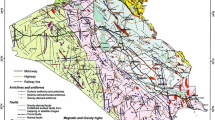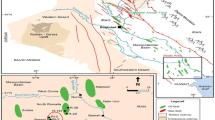Abstract
Based on data of core, thin section, well logging and capillary pressure curves, starting from rock and pore types, reservoir classification is carried out integrating macro and micro perspectives, which can comprehensively reflect the relationship between pore and permeability and micro-pore structure of reservoir and seepage ability. Studied area was subdivided into five kinds of reservoirs, i.e., Class I, Class II, Class III, and Class IV and Class V. Among them, quality of the Class I, dominated by rudstone, were the best with high-porosity and ultra-high-permeability. The quality of reservoirs gradually deteriorated from Class I to Class V. Studies revealed that the formation of reservoirs was affected by sequence stratigraphy, sedimentation, and diagenesis strongly. The high-water system tract and transgressive system tract form a vertical periodic distribution of reservoirs. Reef flats and open platform facies were more conducive to the formation of high-quality reservoirs, such as grainstone, while subtidal zone and lagoon facies were more favorable for the formation of mud supported structure, such as wackstone and mudstone. Late dissolution played major roles in the increase of secondary pores, such as vugs and moldic pores. Cementation, compaction and micritization reduced primary pore and reduced reservoir quality. The new reconstructed parameters RG (resistivity to natural gamma ray ratio, RG = ILD/GR) and RD (acoustic time difference to density ratio, RD = DT/ RHOB) could be used to accurately identify reservoir types. The results show that prediction accuracy of this method is up to 90%, which can meet the requirements of fine reservoir evaluation.













Similar content being viewed by others
References
Ahr WM (2008) A new genetic classification of carbonate porosity and its application to reservoir characterization. American Association of Petroleum Geology Annual convention (Abstract), San Antonio, pp 20–23
Al-Sakini JA (2010) Summary of petroleum geology of Iraq and the Middle East. Northern Petroleum Company, Kirkuk
Alsharhan AS (1995) Facies variation, diagenesis, and exploration potential of the Cretaceous rudist-bearing carbonates of the Arabian Gulf. AAPG Bull 79:531–550
Aqrawi AM, Goff JC, Horbury AD et al (2010) The petroleum geology of Iraq (2010). Scientific Press, Beaconsfield
Awadeesian AMR, Al-Jawed SNA, Saleh AH (2015) Reservoir scale sequence stratigraphy of Mishrif carbonates and implication to water injection strategy North Rumaila field case. Arab J Geosci 8(9):7025–7040
Bendias D, Aigner T (2015) Facies, sequence stratigraphy, reservoir and seal potential of the Mafraq Formation, Sultanate of Oman: an integrated outcrop analogue study. GeoArabia 20:17–26
Cantrell DL, Shah A (2020) Depositional and diagenetic controls on reservoir quality: example from the upper Cretaceous Mishrif Formation of Iraq. Mar Petrol Geol 12:221–232
Choquette PA, Pray LC (1970) Geological nomenclature and classification of porosity in sedimentary carbonate. AAPG Bull 54(2):207–250
Davies RB, Casy DM, Horbury AD (2002) Early to Mid-Cretaceous mixed carbonate-clastic shelfal systems: examples, issues and models from the Arabian Plate. GeoArabia 7:541–578
Deng HC, Zhou W, Guo R et al (2014) Pore structure characteristics and control factors of carbonate reservoirs: the Middle-Lower Cretaceous formation, AI Hardy cloth Oilfield, Iraq. Acta Petrol Sin 30:801–812
Dickson JAD (1966) Carbonate identification and genesis as revealed by staining. J Sediment Pet 36(2):491–505
Dunham RJ (1962) Classification of carbonate rocks according to depositional texture. AAPG Memoir 1:108–121
Esrafili-Dizaji H, Rahimpour-Bonab H (2009) Effects of depositional and diagenetic characteristics on carbonate reservoir quality: a case study from the South Pars gas field in the Persian Gulf. Petrol Geosci 15:325–344
Gao JX, Tian CB, Zhang WM (2013) Characteristics and genesis of carbonate reservoir of the Mishrif Formation in the Rumaila oil field, Iraq. Acta Pet Sin 34(5):844–854
Ghanem H, Kuss J (2013) Stratigraphical control of the Aptian-Early Turonian sequences of the Levant Platform, costal range, northeast. GeoArabia 18:85–132
Gundog AS, Ross CM, Akin S (2016) Multiscale pore structure characterization of Middle East carbonates. J Petrol Sci Eng 146:570–583
Han HY, Mu LX (2014) Characteristics and main controlling factors of Cretaceous bioclastic limestone reservoir in Al-Ahdaib Oilfield, Iraq. Mar Petrol Geol 19:54–58
He J, Sun LC, Je Ni (2018) Characteristics and heterogeneity of the diamictite reservoir in B Member of Asmari Formation in M oilfield, Iraq and their impacts on development. China Offshore Oil Gas 30:127–134
Hong HT, Yang Y (2012) The characteristics and development law of marine carbonate reservoirs in Sichuan Basin, China. Acta Petrol Sin 33:64–70
Hou LH, Yang F, Yang C (2020) Characteristics and formation of sinian (Ediacaran) carbonate karstic reservoirs in Dengying Formation in Sichuan Basin, China. Petrol Res 12:21–37
Hulea IN, Nicholls CA (2012) Carbonate rock characterization and modeling: capillary pressure and permeability in multimodal rocks-a look beyond sample specific heterogeneity. AAPG Bull 96:1627–1642
Hussain SA, Ahmad K (2020) Facies architecture, Diagenesis and Paleoceanography of Mishrif (Late Cretaceous) in Selected Wells of West Qurna Oil Field, Southern Iraq. J Phys Conf Ser 2020:1–17
Jia J (2019) Comprehensive evaluation for effectiveness of complex carbonate reservoir: a case from Tishirine Oilfield in Syria. Reserv Eval Dev 10:30–36
Kakemem U, Jafarian A (2016) Facies, sequence framework, and reservoir quality along a Triassic carbonate ramp: Kangan Formation, South Pars Field, Persian Gulf Superbasin. J Petrol Sci Eng 30(3):1–15
Lai J, Wang G, Cao JT (2018) Investigation of pore structure and petrophysical property in tight sandstones. Mar Pet Geol 91:179–189
Li FF, Guo R, Liu LF (2020) Heterogeneity genesis of bioclasts limestone reservoirs of Cretaceous Mishrif Formation in M Oilfield, Iraq. J Earth Sci Environ 42(3):297–308
Liu JQ, Gao JX, Liu B (2019) Mainly geological control factors and distribution of the Upper Cretaceous Mishrif Carbonate Reservoir, R Oilfield in the Middle East. Bull Sci Technol 35:13–22
Mahdi TA, Aqrawi AAM (2014) Sequence stratigraphic analysis of the Mid-Cretaceous Mishrif Formation, southern Mesopotamian Basin, Iraq. J Petrol Geol 37:287–312
Mehdi A (2010) Accurate determination of permeability in carbonate reservoirs using Gaussian Process Regression. J Petrol Sci Eng 12:886–901
Moore CH, Wade WJ (2013) Carbonate reservoirs: porosity and Diagenesis in a sequence stratigraphic framework, 2nd edn. Elsevier, Kidlington
Ran JB (2004) Comprehensive study of carbonate reservoir in AHDAB oilfield. Geophys Prospect Petrol 39:304–310
Ren J, Tian YM, Wang J et al (2020) The characteristics and classification evaluation of reef-shoal Facies reservoir in Puguang gas field. Fault-Block Oil Gas Field 27:579–588
Reza MM (2018) The Assessment of microfacies and reservoir potential relationship (porosity and pore size) of the Sarvak Formation in SW Iran. Geosci J 22:793–805
Sadoon FN (1996) Stratigraphic and lithological characteristics of Upper Cretaceous carbonates in central Iraq. J Petrol Geol 19:271–288
Sharland PR, Archer R, Casey DM (2001) Arabian plate sequence stratigraphy. GeoArabia Special Publication, 2. Gulf Petrolink, Bahrain, p 387
Sun CJ, Fu MY (2013) Influence of early diagenesis on reservoir properties of Rumaila Formation in an oilfield. Complex Hydrocarbon Reservoirs 6:23–29
Thehni GA (1998) Mid-cretaceous Rudist-bearing carbonates of the Mishrif formation: an important reservoir sequence in the Mesopotamian basin, Iraq. J Petrol Geol 21:57–68
Vincent B, Van Bunchem FSP, Bulot LG et al (2015) Depositional sequences, diagenesis, and structural control of the Arabian to Turonian carbonate platform systems in costal Fars. Mar Pet Geol 63(3):46–67
Wang J (2010) Early Cretaceous Lekhwair formation in ABU Dhabi, UAE Microfacies characteristics of offshore carbonate rocks. J Oil Gas Technol 32:33–39
Wang X, Zhou W (2017) Shoal facies reservoir characteristics and genesis of Mishrif formation in Halfaya oilfield, Iraq. J Jilin Univ 47:1007–1020
Wang YX, Tian CB, Gao JX (2013) A quantitative exploration of carbonate microfacies based on conventional logging data: a case study of the Mishrif formation in north Rumaila oil field of Iraq. Acta Perol Sin 34:1088–1099
Wang YL, Song XM, Wang GH (2020) Key technologies and practices for rapid and large-scale production increase in cooperation oil and gas fields of the Middle East. Acta Petrol Sin 41:1633–1643
Xia DD, Qiang SML (2014) Genesis of low resistivity limestone reservoirs in Oilfield A of Syria. J Southwest Petrol Univ (science & Technology Edition) 36:81–90
Yu YC, Sun LD, Song XM (2018) Sedimentary diagenesis of rudist shoal and its control on reservoirs: a case study of Cretaceous Mishrif Formation, H, oilfield. Iraq 45:1007–1019
Yu YC, Song XM, Guo R (2019) Bioclastic types of the Mishrif formation in the H oilfield in Iraq and the controlling effect on reservoir physical properties. Geol Rev 65:262–265
Zhao LM, Zhou Zhong Y (2019) Control factors of reservoir oil-bearing difference of Cretaceous Mishrif formation in the H oilfield, Iraq. Petrol Explor Dev 46:314–323
Zhou W, Guo R (2014) Characteristics and origin of Cretaceous limestone reservoir with bio-moldic pore and intrafusal pore, in Ahdaib, Iraq. Acta Petrol Sin 30:813–821
Acknowledgements
We acknowledge the use of oilfield data and suggestions of Prof. Feng and my cooperating team. We thank data collection of my colleague.
Funding
Funding was supported by the National Science and Technology Major Project [Grant No. 2020ZX05008-002].
Author information
Authors and Affiliations
Corresponding author
Additional information
Publisher's Note
Springer Nature remains neutral with regard to jurisdictional claims in published maps and institutional affiliations.
Rights and permissions
About this article
Cite this article
Fang, X., Feng, H., Wang, H. et al. Study on origin, classification, and identification of complex porous carbonate reservoir: a case study of the middle cretaceous Mishrif Formation in W Oil field. Carbonates Evaporites 36, 72 (2021). https://doi.org/10.1007/s13146-021-00737-2
Accepted:
Published:
DOI: https://doi.org/10.1007/s13146-021-00737-2




